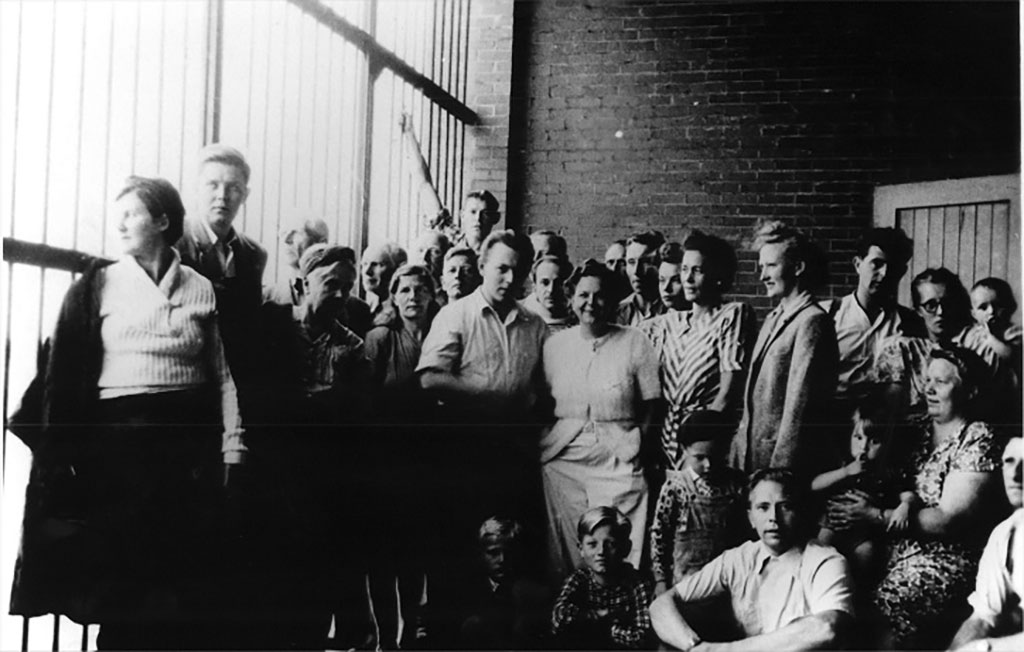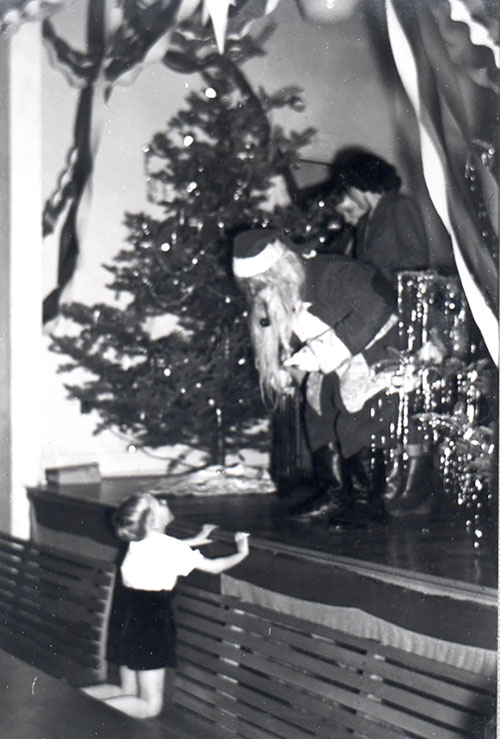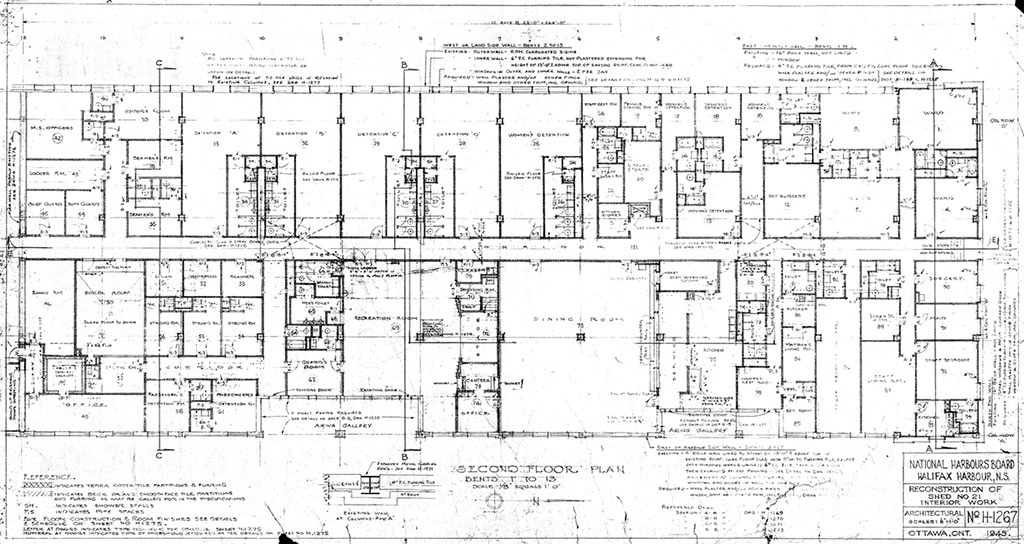by Steve Schwinghamer, Historian
(Updated July 20, 2021)
Introduction: Accommodation and Detention at Pier 21
Pier 21 is best known as Halifax’s receiving station for almost one million immigrants to Canada, and as a key embarkation facility during the Second World War. However, most of the people who passed through the waterfront facility only saw one of the most important areas of the site if something went wrong during their examinations. If there was a problem with their admissibility—perhaps a job arrangement that fell through, or a discrepancy in papers that required a check—applicants for entry could be delayed and detained. They would then be placed in Pier 21’s immigration quarters.
Pier 21 operated two kinds of quarters: “accommodation” for people who were delayed due to minor issues, and “detention” for people held for security reasons. The accommodation dormitories ran along the west (inland) wall of the second storey of Shed 21. These were large, plain rooms with simple metal beds and adjoining bathrooms, secured against escapes with bars or mesh in the windows.[1]

Credit: Canadian Museum of Immigration at Pier 21 Collection (DI2014.438.1)
People who were in the larger dormitories were usually free to leave the facility during the day. By contrast, confinement in the strong rooms, which were located in the centre of the second storey of Shed 21, was more strict. It was also much less common.[2] The cells were generally used only when a person was thought to be a significant security risk. In those cases, staff at the Pier had access to restraints, such as handcuffs or shackles, appropriate to containing dangerous prisoners.[3] A person being detained in one of these cells would pass through a rigorous search of their person and their property, with items down to toiletries being temporarily confiscated. Guards were also directed to avoid conversation with detainees outside of what was necessary for the completion of duties.[4] Although the total numbers varied slightly as the interior was altered over time, Pier 21 could accommodate about 150 immigrants in dormitories, and about 12 to 16 in strong rooms.
Memories of Detention
Regardless of the level of security, immigrants who were detained often had the sense of being “locked up.” As recalled by Tibor Lukacs, who was 11 when his family arrived in Canada after the Hungarian Revolution,
“We arrived here in this building, in Pier 21, and we got off the bus and we were processed and I remember that we sat in a small office and I think they asked us, from there, they asked us questions. They had a flip folder which they opened up and they put in front of my dad and asked which of these parties did you belong to in Hungary. I remember that. I remember this. And we were processed and we were then separated. The families were separated, boys and men were in room—separate rooms from the women and girls. Interesting enough, we found out that, in fact, this was the prison, which most people don't know. This was, in fact, the prison.”[5]
Jackie Eisen, also 11, remembers her family’s confinement at the Pier in a similar way:
“And every morning they would open the door and let us out and every night, I think eight o’clock or nine o’clock, they would lock the doors. And our room faced the railroad tracks and my sister and my mother and I would look, I’m not joking, we would be like this. Tears running down our faces, seeing all these people getting on their trains and going and we were still there. And we were here for three months.”[6]
Life in the Immigration Quarters

Credit: Canadian Museum of Immigration at Pier 21 Collection (DI2014.443.47)
Immigration guards controlled access to and from the space, but within it, there were recreation areas, airing galleries and dining facilities for the comfort of immigrants who had to wait before carrying on to their destinations in Canada.[7] Detained applicants used the recreation area to stage entertainment if they were in the immigration quarters over a festival, as was the case for a large group of Baltic refugees held over Christmas in 1948.[8] Members of the immigration staff, the matrons, were charged with the welfare of immigrants held in the detention quarters. After the Second World War, one of the matrons lived in a small apartment inside the immigration facility at Pier 21.[9]
Initially, accommodations were segregated not only based on gender but also on an immigrant’s status as a British Subject or a foreigner.[10] This meant there were a total of four regular accommodation dormitories, and a fifth was reserved for detained mariners. This changed after the Immigration Quarters at Pier 21 were destroyed by fire in 1944. The facility was rebuilt with four dormitories for men; one women’s dormitory; and a set of smaller detention rooms for families, women and mariners.[11]
Conclusion: After 1971
Pier 21’s accommodation arrangements were well-used during the peak periods of traffic through the shed, during and after the Second World War. When the facility was closed in 1971, the immigration department returned to using local hotels and jails as a replacement for the two kinds of quarters that had been at the heart of the waterfront facility.

Credit: Halifax Port Authority
- Barnstead to Fraser, Halifax, 23 November 1926, Department of Immigration, “Immigration Building at Halifax, Nova Scotia (map) (plans)”, Library and Archives Canada, RG 76 Volume 666 File C1594; H. Crude, “CNR Halifax Ocean Terminals Proposed Immigration Facilities Shed No. 21 Gratings for Types ‘A’, ‘B1’ & ‘B2’ Windows”, 25 November 1926, Drawing 51103-503, consulted via Halifax Port Authority
- Charles Dwyer, interviewed by James Morrison, 24 March 1998, Canadian Museum of Immigration Oral History Collection, 98.03.24CD, 00:12:59
- Bill Marks, interviewed by James Morrison, 24 April 1998, Canadian Museum of Immigration at Pier 21 Oral History Collection, 98.04.24BM, 00:59:55
- Department of Citizenship and Immigration, “Administration Chapter 24: Management of Immigration Halls and Detention Quarters” in “Immigration Manual: First Series”, Library and Archives Canada RG 76 Vol 939 Binder 22, sections 24.09 and 24.41 as amended 27 September 1954.
- Tibor Lukacs, interviewed by Steven Schwinghamer, 9 December 2006, Canadian Museum of Immigration at Pier 21 Oral History Collection, 06.12.09TL, 00:48:35
- Jackie Eisen, interviewed by Amy Coleman, 16 July 2003, Canadian Museum of Immigration at Pier 21 Oral History Collection, 03.07.16JE, 00:24:03
- Public Works Canada, “Dept of Immigration Pier 21 Halifax, NS, 2nd Floor Plan”, March 1956, Drawing 51103-412, consulted via Halifax Port Authority
- H.P. Wade, Assistant Inspector-in-Charge, to H.U. McCrum, Atlantic District Superintendent, Halifax, 5 January 1949 in “Admission to Canada of the Corvette Walnut”, Library and Archives Canada, RG 76 Vol 668 File C19279
- Public Works, “Pier 21 2nd Floor Plan”; Alison Trapnell interviewed by James Morrison, 16 April 1998, Canadian Museum of Immigration at Pier 21 Oral History Collection 98.04.16AT, 00:23:12
- “Splendid Facilities”, Chronicle (Halifax), 3 March 1928
- National Harbours Board, “Reconstruction of Shed No. 21 – Interior Work”, No. H-1267, Ottawa, 1945, consulted via Halifax Port Authority (unaccessioned collection)